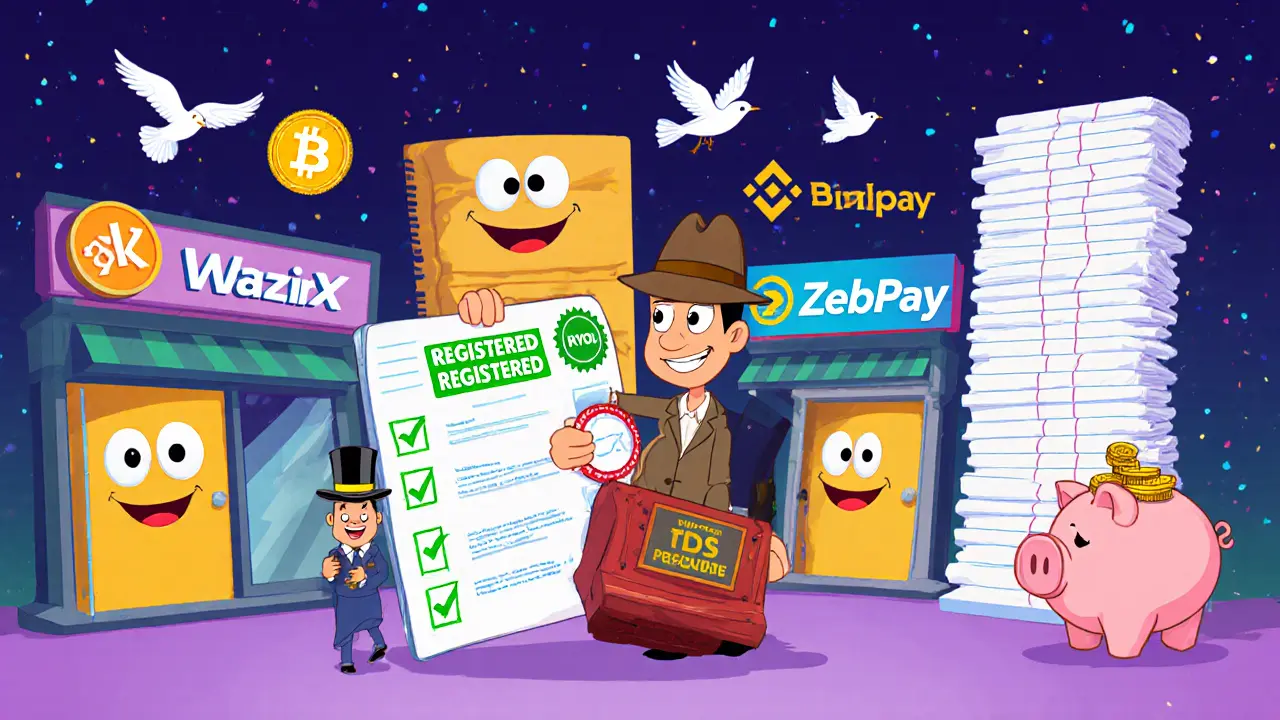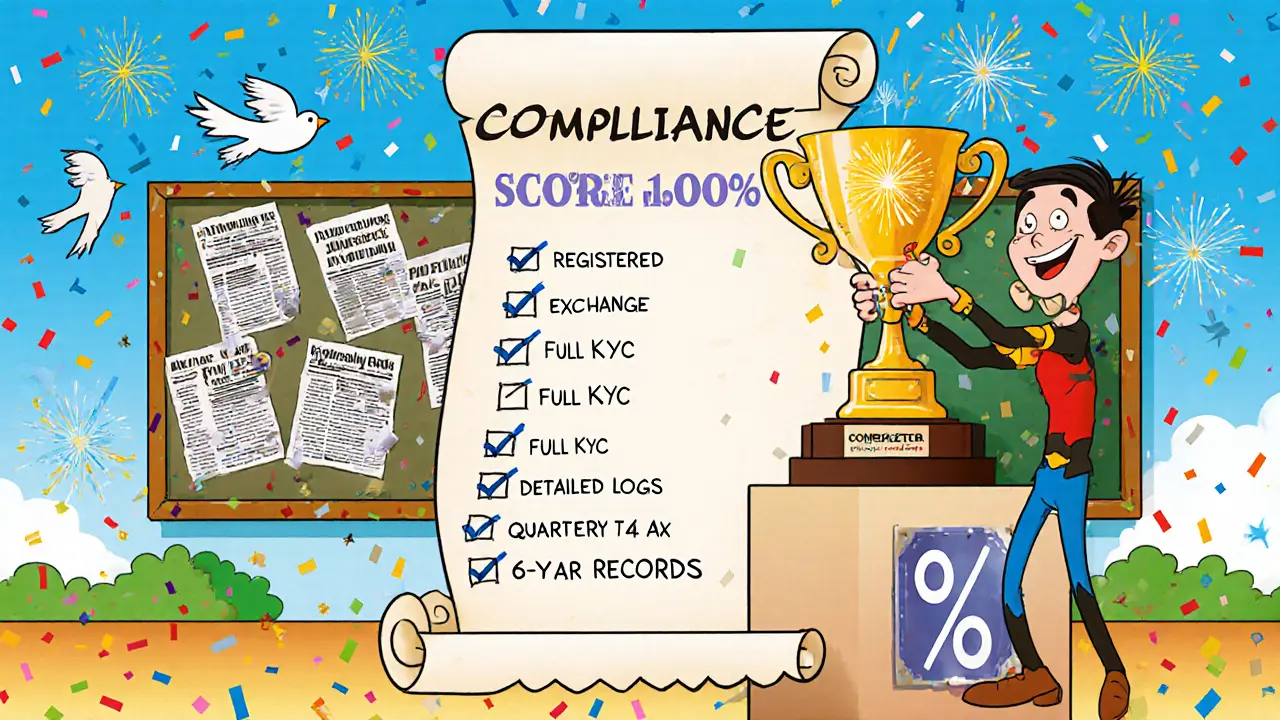
Crypto Compliance Checker
Which exchange do you primarily use for trading?
Have you completed full KYC verification?
Do you maintain detailed logs of all transactions?
Are you filing quarterly tax returns based on your crypto gains?
Do you retain transaction records for at least 6 years?
0%
Compliance Level
- Use only FIU-IND registered exchanges
- Complete full KYC verification
- Maintain transaction logs for 6 years
- File quarterly tax returns
- Claim TDS credits when filing
- Stay updated on regulatory changes
India’s crypto scene isn’t a black‑hole of bans; it’s a maze of tax rules, AML checks, and registration mandates. If you’re looking to keep your crypto activities smooth and avoid the dreaded legal hiccups, the best move is to work *within* the framework rather than trying to sidestep it.
Understanding the Current Legal Landscape
Cryptocurrency is a digital asset secured by cryptography, used for transactions and investment in India falls under the definition of a Virtual Digital Asset (VDA). The Supreme Court’s 2020 decision overturned the RBI’s earlier ban, and since then the Income Tax Act (amended by the 2025 Income Tax (No.2) Bill) treats gains from VDA transfers as taxable income.
The tax rate is a flat 30% on all crypto gains plus a 1% TDS on every transaction. No deductions are allowed - this makes India one of the highest‑taxed crypto markets globally.
Regulatory oversight isn’t limited to tax. The Financial Intelligence Unit‑India (FIU‑IND) enforces anti‑money‑laundering (AML) rules, while bodies like the Reserve Bank of India (RBI) and the Securities and Exchange Board of India (SEBI) shape broader policy. In short, the Indian approach is “regulation through taxation” rather than outright prohibition.
Job #1: Choose a Registered Exchange
Only exchanges that have completed FIU‑IND registration can legally operate. Using a non‑registered platform opens you up to penalties and possible asset freezes.
Here are the most reliable options as of 2025:
- WazirX - Indian‑headquartered, full KYC, auto‑generates tax documents.
- CoinDCX - Offers advanced charting, supports multiple VDA pairs, compliant with FIU‑IND.
- ZebPay - Long‑standing exchange, robust AML reporting.
- Binance - Global exchange that resumed Indian operations in 2024 after meeting FIU‑IND requirements.
Never trust a platform that claims “no KYC” or “off‑shore only” - those are red flags for non‑compliance.
Job #2: Implement Rock‑Solid KYC & AML Practices
FIU‑IND demands:
- Verified identity documents (Aadhaar, PAN).
- Proof of address and source of funds.
- Continuous transaction monitoring for suspicious patterns.
- Annual filing of a Suspicious Activity Report (SAR) if required.
Most registered exchanges handle the first two steps automatically. For larger traders or businesses, you’ll need an internal compliance system - think of a simple spreadsheet or a dedicated crypto accounting tool that flags large transfers, rapid sell‑offs, or transactions with high‑risk jurisdictions.
Job #3: Master Record‑Keeping and Tax Filing
The law requires you to keep every trade’s details for at least six years. Your record should capture:
- Date and time of each transaction.
- Asset transferred (e.g., BTC, ETH, NFT).
- Quantity and price in INR at the moment of trade.
- Transaction type (buy, sell, swap, transfer).
- Purpose (investment, payment, gifting).
Once you have a clean ledger, calculate your taxable gain:
- Identify the cost basis - the INR amount you originally paid for the asset.
- Subtract the cost basis from the sale proceeds (including any crypto‑to‑crypto swaps, which are taxable events).
- Apply the 30% flat rate to the net gain.
- Remember the 1% TDS will already be deducted by the exchange; you’ll claim it as a tax credit when filing.
If you’re unsure, a crypto‑specialized chartered accountant can save you from costly mistakes.

Job #4: Stay Ahead of Regulatory Updates
India’s policy is evolving. New guidelines often appear as circulars from the CBDT or as notifications from FIU‑IND. Here’s a quick routine to stay informed:
- Subscribe to the official FIU‑IND blog - they post compliance checklists quarterly.
- Follow reputable Indian crypto news sites (e.g., CoinCrunch, CryptoTimes).
- Join local trader groups on Telegram or Reddit; these communities flag sudden enforcement actions.
- Review your exchange’s compliance updates at least once a month.
When a change is announced, assess whether it affects your current workflow. Most adjustments involve documentation tweaks, not a complete overhaul.
Job #5: Avoid Common Pitfalls that Trigger Restrictions
Even seasoned traders slip up. The most frequent triggers are:
- Using unregistered exchanges. The government has already shut down 25 platforms for non‑compliance.
- Skipping KYC on “peer‑to‑peer” trades - these are treated like informal transfers and can be flagged as tax evasion.
- Failing to report crypto‑to‑crypto swaps - every swap is a taxable event under the Income Tax Act.
- Neglecting the 6‑year record‑keeping rule - audits can go back that far.
- Ignoring TDS receipts - you’ll lose a tax credit if you don’t claim it.
By crossing these off your checklist, you essentially dodge the “restrictions” most people worry about.
Comparison: Compliant vs Non‑Compliant Crypto Practices
| Aspect | Compliant Approach | Non‑Compliant Approach |
|---|---|---|
| Exchange Used | FIU‑IND registered (WazirX, Binance, CoinDCX) | Unregistered, offshore, “no‑KYC” platforms |
| KYC/AML | Full identity verification, transaction monitoring | Minimal or no verification, hidden wallets |
| Tax Reporting | Accurate ledger, quarterly tax filing, TDS credit claimed | Undeclared gains, missing TDS, risk of penalties |
| Record Keeping | 6‑year digital archive, exportable CSVs | Ad‑hoc notes, no audit trail |
| Regulatory Risk | Low - only routine compliance checks | High - potential account freezes, fines up to 200% of tax due |
Real‑World Example: Turning a Near‑Miss into Full Compliance
Rahul, a Delhi‑based trader, was using a peer‑to‑peer app to swap Bitcoin for Ethereum. The platform wasn’t FIU‑IND registered, and he didn’t keep any paperwork. When the tax authorities launched a random audit, his 12‑month ledger showed gaps, leading to a notice for “tax evasion”.
Instead of fighting, Rahul switched to WazirX, exported his past transaction history, and hired a crypto accountant. He filed revised returns, claimed the TDS, and paid a modest penalty. Six months later, his account was fully cleared, and he now enjoys uninterrupted trading.
The lesson? One compliance tweak can turn a legal headache into a smooth ride.
Step‑by‑Step Checklist to Stay Legal
- Open an account on a FIU‑IND registered exchange (WazirX, CoinDCX, Binance).
- Complete full KYC - upload Aadhaar, PAN, and address proof.
- Set up a spreadsheet or crypto‑accounting software to log every transaction.
- Calculate quarterly gains and upload them to your income tax filing portal.
- Retain all records (CSV exports, screenshots of TDS) for at least six years.
- Review FIU‑IND circulars quarterly and adjust your process if needed.
- Consult a tax professional for complex swaps or large‑scale trades.
Follow these steps and you’ll effectively sidestep the crypto restrictions India conversation - because you’ll be operating within the law.

Frequently Asked Questions
Do I need to pay tax on crypto earned from a foreign exchange?
Yes. Indian tax law treats any gain from virtual digital assets, regardless of where the exchange is based, as taxable income. You must report the INR‑valued profit and pay the 30% flat rate, plus claim any TDS deducted.
Is crypto‑to‑crypto swapping a taxable event?
Absolutely. The Income Tax Act considers each swap a transfer of a VDA, which triggers capital‑gain calculation. Record the market value of both assets at the swap moment.
Can I use a non‑registered exchange if I keep my trades small?
No. The law doesn’t differentiate by trade size. Using an unregistered platform exposes you to penalties, account freezes, and possible criminal proceedings.
How long must I keep crypto transaction records?
Six years, as stipulated by the Indian Income Tax Act. Audits can reach back that far, so maintain organized, searchable records.
What happens if I miss the 1% TDS deduction?
The TDS is automatically withheld by the exchange. If you don’t claim it on your return, you’ll effectively pay extra tax. Always verify the TDS credit appears in your Form 26AS.





